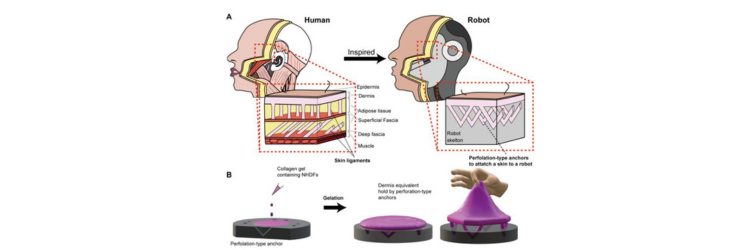
Researchers at the University of Tokyo are binding engineered skin tissue to complex humanoid robot forms. The goal? Increased mobility, self-healing, embedded sensing, and a more lifelike appearance. The team included special perforations in a robot’s face, helping the layer of skin take hold. The team believes there are applications in the cosmetics industry and in training plastic surgeons.
Looking for improved adhesion between robotic features and the subcutaneous structure of the skin, the researchers found that by mimicking human skin-ligament structures and using specially made V-shaped perforations in solid materials, the skin would bind to complex structures.
Previous methods could only attach tissue to limited surfaces, risking damage during motion. Now, researchers can apply skin to any surface shape by engineering small perforations. By using a common technique for plastic adhesion called plasma treatment, they coax the collagen into the fine structures of the perforations while holding the skin close to the surface.
Living skin brings a range of new abilities to robots, including self-healing. Some chemical-based materials can heal but require triggers such as heat, pressure, or other signals, and they don’t proliferate like cells. Biological skin repairs minor lacerations and scientists can add nerves and other skin organs for use in sensing and so on.
The idea of an organ-on-a-chip is not especially new. What is new is the concept of a face-on-a-chip that could be useful in research into skin aging, cosmetics, surgical procedures, plastic surgery, and more. By embedding sensors, robots gain better environmental awareness and improved interactive capabilities.
The research had some wins but also identified new challenges, such as the need for surface wrinkles and a thicker epidermis to achieve a more humanlike appearance by incorporating sweat glands, sebaceous glands, pores, blood vessels, fat, and nerves. Movement is also a challenge that is met by integrating sophisticated actuators or muscles inside the robot.
